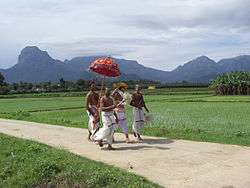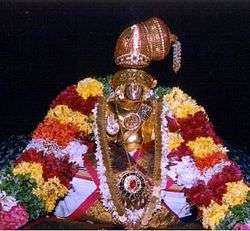Vaishnava Nambi and Thirukurungudivalli Nachiar Temple
| Vaishnava Nambi | |
|---|---|
 | |
 Vaishnava Nambi Location in Tamil Nadu | |
| Name | |
| Proper name | Thirukkurungudi |
| Geography | |
| Coordinates | 8°26′09″N 77°33′58″E / 8.43583°N 77.56611°ECoordinates: 8°26′09″N 77°33′58″E / 8.43583°N 77.56611°E |
| Country | India |
| State | Tamil Nadu |
| District | Tirunelveli |
| Location | Thirukkurungudi |
| Culture | |
| Primary deity |
Vaishnava Nambi (Vishnu) |
| Consort |
Neela Devi (Lakshmi) |
| Poets |
Tirumangai Alvar Bhoothathalvar |
| Architecture | |
| Architectural styles | Dravidian architecture |
Vaishnava Nambi and Thirukurungudivalli Nachiar Temple in Thirukkurungudi, a village in Tirunelveli district in the South Indian state of Tamil Nadu, is dedicated to the Hindu god Vishnu. It is located 45 km from Tirunelveli. Constructed in the Dravidian style of architecture, the temple is glorified in the Divya Prabandha, the early medieval Tamil canon of the Azhwar saints from the 6th–9th centuries AD. It is one of the 108 Divyadesam dedicated to Vishnu, who is worshipped as Vaishnava Nambi and his consort Lakshmi as Thirukurungudivalli.[1] The temple is locally referred as Dakshina Vaikuntam, the holy abode of Vishnu.
A granite wall surrounds the temple, enclosing all its shrines and two of its three bodies of water. The rajagopuram, the temple's gateway tower, is 110 ft (34 m) tall. Vaishnava Nambi is believed to have appeared to slay the demon Somuka who abducted the four Vedas. The temple follows Thenkalai tradition of worship. Six daily rituals and three yearly festivals are held at the temple, of which the ten-day annual Brahmotsavam during the Tamil month of Chittirai (April - May) and Brahmotsavam during the month of Chittirai, being the most prominent. The temple is maintained and administered by the Hindu Religious and Endowment Board of the Government of Tamil Nadu.
Legend

As per accounts in the Varaha Purana, a treatise of Varaha, an avatar of Vishnu, Varaha preferred to stay at this place with his consort Varahi in a small form and hence came to be known as Thirkurungudi (literally meaning a small house). As per Hindu legend, Nambaduvan, a peasant and singer (locally called panan) from lower section of the society, was an ardent devotee of Vishnu. On account of his low life, he never entered the temple and worshipped from outside. While walking towards the temple one day, he was stopped by a demon. He sang the verses which he set for the presiding deity to him. He also assured the demon that he will come back from the temple when the demon can consume him. Nambi, the presiding deity was pleased by his devotion and appeared outside the temple. While returning, Nambi appeared as a Brahmin and tried to convince him to escape the demon. But Nambudavan was staunch and wanted to be true to his promise. The demon was pleased by the songs and said it did not want to consume him anymore. It is believed that the demon was a Brahmin who was cursed during his previous birth as he was not sincere doing his penance. He was relieved off his curse listening to the songs of Nambaduvan.[2]
Architecture
Vaishnava Nambi temple is located in Thirukkurungudi, a village in Tirunelveli district in the South Indian state of Tamil Nadu. It is located 45 km (28 mi) from Tirunelveli and 11 km (6.8 mi) from Nanguneri. The temple has a flat entrance tower and a five-tiered gopuram (gateway tower). The temple has five prakarams, closed precincts of a temple and all the shrines are enclosed in the first two enclosures.[3][4] The temple occupies around 18 acres (7.3 ha). There are a number of halls, that have sculpted pillars from the Nayak period.[2] There is a shrine to Shiva in the temple, which is an unusual feature in Vishnu temples. There are two other temples namely Tiruparkadal Nambi located half a mile away from the temple and Malai Nambi temple located uphill.[5]
History
The temple has inscriptions from the 10th century during the Medieval Chola period indicating grants to the temple in the form of sheep. Another inscription from the 14th century is attributed to Sundara Pandya II indicating gifts of 25 cows for the perpetual lighting of ghee lamps in the temple. There are also inscriptions from the same regime indicating gift of lands to the temple. The Nayak period during the 15th century saw lot of additions to the temple complex in terms of pillared halls.[2]
Religious significance

The temple is revered in Nalayira Divya Prabandham, the 7th–9th century Vaishnava canon, by Peyazhwar, Nammazhwar, Thirumangai Azhwar and Thirumalisai Alvar. The temple is classified as a Divyadesam, one of the 108 Vishnu temples that are mentioned in the book. During the 18th and 19th centuries, the temple finds mention in several works like 108 Tirupathi Anthathi by Divya Kavi Pillai Perumal Aiyangar. It is believed that Thirumangai Azhwar spent his last days in this place and attained Moksha. The place is thus referred as Dakshina Vaikuntam, the ultimate destination of Vaishnavites. A tradition of worshipping Vishnu through dance, music and art is called Kaisika Nataka is believed to have originated at Thirukkurungudi. A festival called Kaisika Ekadasi held at the temple every year. The local belief is that the devotees practising Kaisika Vratha or witnessing the performance would attain Moksha. Arayar Sevai, another form of worshipping Vishnu is also believed to have originated in this place. As per legend, the practise was established by Nathamuni, who was practising with his fellow mates and Vishnu was hiding in the South Mada street and enjoying the performance. Vishnu is also called as Gana Priyan, the one who enjoys music.[2] It is believed that Ramanuja, the proponent of Vaishavadvaita philosophy taught Vishnu about Astakshara and hence the presiding deity came to be known as Vaishnava Nambi.[5]
Festival
The Chittirai utsavam(festival) in the month of Chittirai (April - May), Vaikasi Jestabishekam during June, Aavani Pavithrotsavam during Aavani (August - September), Float festival during Thai (January - February) and Brahmostavam during March–April are the major festivals in the temple.
The temple follows the traditions of the Thenkalai sect of Vaishnavite tradition and follows Pancharathra aagama. The temple priests perform the pooja (rituals) during festivals and on a daily basis. As at other Vishnu temples of Tamil Nadu, the priests belong to the Vaishnavaite community, a Brahmin sub-caste. The temple rituals are performed four times a day: Kalasanthi at 8:00 a.m., Uchikalam at 12:00 p.m., Sayarakshai at 6:00 p.m., and Ardha Jamam at 8:00 p.m. Each ritual has three steps: alangaram (decoration), neivethanam (food offering) and deepa aradanai (waving of lamps) for both Vaishnava Nambi and Thirukurungaivalli. During the last step of worship, nagaswaram (pipe instrument) and tavil (percussion instrument) are played, religious instructions in the Vedas (sacred text) are recited by priests, and worshippers prostrate themselves in front of the temple mast. There are weekly, monthly and fortnightly rituals performed in the temple.[6]
References
- ↑ M. S., Ramesh (1993). 108 Vaishnavite Divya Desams: Divya desams in Pandya Nadu. Tirumalai-Tirupati Devasthanam..
- 1 2 3 4 S., Prabhu (2 August 2012). "How to reach Thirukkurungudi". The Hindu. Retrieved 25 October 2015.
- ↑ Tourist Guide to South India .Various authors. Page 117.
- ↑ M., Rajagopalan (1993). 15 Vaishnava Temples of Tamil Nadu. Chennai, India: Govindaswamy Printers. pp. 129–143.
- 1 2 R., Dr. Vijayalakshmy (2001). An introduction to religion and Philosophy - Tévarám and Tivviyappirapantam (1st ed.). Chennai: International Institute of Tamil Studies. pp. 479–81.
- ↑ "Sri Azhagia Nambirayar temple". Dinamalar. 2014. Retrieved 31 May 2014.
External links
| Wikimedia Commons has media related to Thirukkurungudi. |



